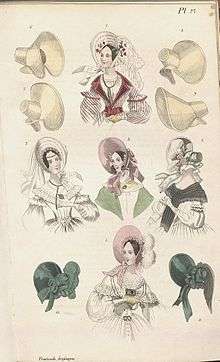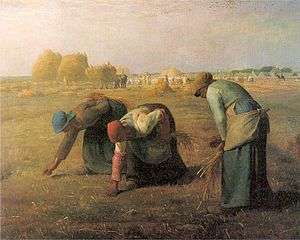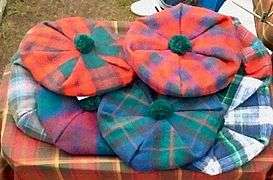Bonnet (headgear)


Bonnet is a term for a wide variety of styles of headgear for both sexes, but most often female, which has been in use from the Middle Ages to the present. It is impossible to generalize as to the styles for which the word has been used, any more than for the alternatives of hat or cap, but there is for both sexes a tendency to use the word for styles in soft material and lacking a brim. However the term has also been used, for example, for steel helmets. This was from Scotland (in 1505), where the term has long been especially popular.[1] Bonnet derives from the same word in French, where it originally indicated a type of material. In the 21st century, only a few kinds of headgear are still referred to as bonnets, most commonly those worn by babies and Scottish soldiers.
Babies
The most common kind of bonnet worn today is a soft headcovering for babies. They are shaped similarly to the kind of bonnets women used to wear, that is they cover the hair and ears, but not the forehead. See also Coif.
Women


In the mid-17th and 18th century "house bonnets" worn by women and girls were generally brimless headcoverings which were secured by tying under the chin, and which covered no part of the forehead. They were worn indoors, to keep the hair tidy, and outdoors, to keep dust out of the hair. With hairstyles becoming increasingly elaborate after 1770, the "calash" was worn outdoors to protect the hair from wind and weather: a hood of silk stiffened with whalebone or arched cane battens, collapsible like a fan or the calash top of a carriage, they were fitted with ribbons to allow them to be held secure in a gale.
From Waterloo, more structured fashionable bonnets made by milliners rapidly grew larger. A plate in La Belle Assemblée 1817 showed a
Bonnet of vermillion-coloured satin, embossed with straw, ornamented slightly with straw-coloured ribbands, and surmounted by a bouquet formed of a full blown damask rose and buds, with ears of ripe corn. This ornament is partially placed on one side: the edge of the bonnet finished by blond [lace] laid on strait.
This was specified as a "carriage dress", with the understanding that when taking the air in an open carriage, the bonnet provided some privacy—such a bonnet was in fact an invisible in Paris—and prevent wind-chapping, with its connotations of countrified rude health. Straw was available again after 1815: the best straw bonnets came from Leghorn. As a bonnet developed a peak, it would extend from the entire front of the bonnet, from the chin over the forehead and down the other side of the face. Some styles of bonnets between ca 1817 and 1845 had a large peak which effectively prevented women from looking right or left without turning their heads: a "coal-scuttle" or "poke" bonnet. Others had a wide peak which was angled out to frame the face. In the 1840s it might be crimped at the top to frame the face in a heart shape. As the bonnet became more complicated, under it might be worn a lace cornette to hold the hair in place.
Bonnets remained one of the most common types of headgear worn by women throughout most of the 19th century. For a widow, a bonnet was de rigueur. Silk bonnets, elaborately pleated and ruched, were worn outdoors, or in public places like shops, galleries, churches, and during visits to acquaintances.
 A millinery shop in Paris, 1822
A millinery shop in Paris, 1822 This portrait of Mrs. Willet Seaman, Jr. (the former Mary Jenkins) of about 1860 features a bonnet. Private collection, Bronxville, New York
This portrait of Mrs. Willet Seaman, Jr. (the former Mary Jenkins) of about 1860 features a bonnet. Private collection, Bronxville, New York
Under the French Second Empire, parasols took the place of protection from sun, and bonnets became smaller and smaller, until they could only be held on the head with hatpins. As hats came back into style, bonnets were increasingly worn by women who wanted to appear modest in public, with the result that bonnets accumulated connotations of dowager wear and dropped from fashion except on the prairies.

Most middle-class women in the 19th century would have had at least two bonnets, one suitable for summer weather, often made from straw, and one made from heavier fabric for winter wear. This is where the tradition of an Easter bonnet originated, when women would switch from their winter bonnet to their summer bonnet. Wealthier women would have many bonnets, suitable for different occasions.
In some religious groups it has been customary for women to wear bonnets. This was the case among the Friends (Quakers) until well into the 20th century, and is still the case among the Old Order Mennonites and the Amish.[2] Bonnets were adopted by The Salvation Army as part of uniform regalia for women. Initially, bonnets were introduced as protection for women soldiers and were reinforced with black tar to turn them into helmets. Later versions were smaller when there was no longer any need for protection. The bonnet has now been replaced with a bowler style hat.
Men
The word "bonnet" for male headgear was generally replaced in English by cap before 1700, except in Scotland,[1] where it remained in use, originally for the widely worn blue bonnet, and now especially for military headgear, like the Feather bonnet (not to be confused with those worn by Native Americans, for which "bonnet" was also used), Glengarry, Kilmarnock and Balmoral. The Tudor bonnet remains a term for a component of the academic regalia of some universities, and is not unlike the common male bonnet of the 16th century.
"Bonnet" is also the term for the puffy velvet fabric inside the coronet of some male ranks of nobility,[3] and "the affair of the bonnets" was a furious controversy in the France of Louis XIV over the mutual courtesies due between the magistrates of the Parlement de Paris and the Dukes of France.
The chile pepper Scotch bonnet was named for its resemblance to a bonnet worn by men in Scotland in the past, as it had a pom pom at the top which indicates the difference form the men's bonnet and women's bonnet.
- The traditional bonnet of the Kilwinning Archers of Scotland.
 Various Tam o' Shanters
Various Tam o' Shanters
Modern French
The term "Bonnet" remains in use in modern European French (France, Belgium, Switzerland...), but uses of "bonnet" in other languages very often do not correspond with those in English. Regarding winter headgear, it is mostly used as common denomination for knitted beanies or ski hats. The term is uncommon with French Canadians who prefer the term tuque to designate those hats.
On November 25, on Catherine of Alexandria's traditional feast day, prayers for her intercession are given. In France, unwed women who have attained the age of twenty-five, wear richly-decorated bonnets on this day to attract potential spouses. Traditionally, only married women wore a bonnet- unmarried women wore a Chaplet, and do not assume a bonnet until their wedding. For that reason, unmarried women are said to have "put on St Catherine's bonnet (coiffer Sainte Catherine)." This custom is explained by the legend. After St Catherine converted the wife of the Roman Emperor Maxentius, she crowned the new Christian empress with a crown she took from one of the angels that had appeared to her.[4]
See also
References
- 1 2 OED, "Bonnet"
- ↑ Bender, Harold S. and Sam Steiner. "Bonnet (1953) Archived September 29, 2007, at the Wayback Machine.." Global Anabaptist Mennonite Encyclopedia Online. 2000. Global Anabaptist Mennonite Encyclopedia Online. Retrieved 2007-04-27.
- ↑ OED, "Bonnet" 4
- ↑ Ciba Review. Number 35, "The Hat." Ciba Corporation: Basle, Switzerland. September 1940, page 1280.
External links
| Wikimedia Commons has media related to Bonnets. |
- Fashion Plates of Female Headgear from The Metropolitan Museum of Art Libraries
- Jonathan Walford, "Women's fashion headwear"
- Mixed Fashion Plates 1800-1900, with original descriptive captions